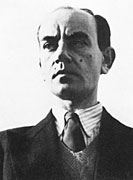He was born in Buenos Aires, on June 14, 1891. At the age of 16 he graduates as an elementary school teacher and music professor, under the direction of Alberto Williams. He works as a teacher and gives music lessons to primary school children. He becomes a member of the Comisión Consultiva de Orientación Artística de la Dirección General de Escultura de la Provincia de Buenos Aires.
Towards 1919, he begins his production of paintings. He becomes a member of the El Bermellón group which meets in La Boca. He would be part of this group from approximately 1919 - 1923 together with painters such as Juan Del Prete, Orlando Stagnaro, Víctor Cunsolo and José Luis Menghi, among others.
As of 1925, he makes nine trips to Europe visiting different artistic centers. He befriends other Argentine artists who will eventually make up the Group of Paris. Parallel to his painting activity he performs several piano concerts in Buenos Aires, Madrid and Paris. In this latter city he will start to frequent the workshop that Horacio Butler possesses on rue Cler, where he paints several nude motives. During this time, Butler portrays Pissarro sitting at his piano. In 1928 they return together to Buenos Aires to ogranize an exhibit of Argentine artists residing in Paris which takes place at Amigos del Arte. In 1929 he accompanies his friend Juan Del Prete, on his first trip to Europe, and they arrive together in Berlin.
His work is shown at the Salones Nacionales as of 1919, and he frequently travels around the country as well. In 1926 he takes part in the Exposición de Artistas Argentinos en París and in 1928; he exhibits at the Galería Carmine of the same city. In Buenos Aires he makes individual exhibits at the Asociación Amigos del Arte in 1926 and 1929, in Boliche de Arte in 1927, in 1930 at Asociación Wagneriana –invited by Alfredo Guttero– and in 1934, at the Galería Müller.
In 1930, he obtains the second prize at the Salón de Arte in Rosario. At the Salón Nacional he wins the “Bolsa” award in 1935 and the "Cecilia Grierson" award in 1936, with his work Retrato de niña (Portrait of a girl), presently shown at the Museo Eduardo Sívori.
He dies in Buenos Aires on December 22, 1937.
In 1938, a post mortem exhibit is organized at the Asociación Amigos del Arte de Buenos Aires in his honor.
Pissarro mostly concentrates his artistic production on the female figure, landscapes, still life and portraits, leaving behind a vast collection of drawings, water prints, water colors and oils.
At the beginning of his career he paints with thick material, which in time he thins out until turning it extremely light, in order to play with an almost sketchy manner. The synthesis of his drawings, the freedom of this strokes, the transparency of color, make his work fresh and clean, yet intensely expressed. The influence of Cézanne and Matisse is evident in different aspects of his work, and relate him with the modern techniques he acquired during his stays in Paris.
His work can be found at the collection of the Museo Nacional de Bellas Artes, Museo Eduardo Sívori, Museo Escolar Fernando Fader in Buenos Aires and Museos Provinciales de Bellas Artes in La Plata, Córdoba, San Juan and Santa Fe, Museo Juan B. Castagnino in Rosario, Museo Pío Collivadino in Banfield, Museo Americanista in Lomas de Zamora (Provincia de Buenos Aires), and important private collections.
